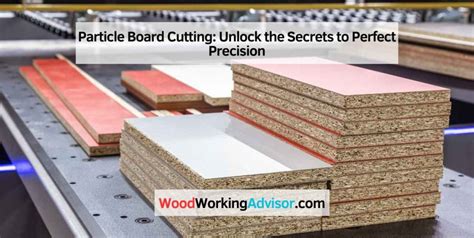Achieve Professional-Looking Cuts on Particle Board: A Comprehensive Guide
Particle board, a cost-effective and widely used material, can be challenging to cut cleanly. Achieving a professional-looking finish requires careful planning and the right techniques. This guide will equip you with the knowledge and strategies to make precise, smooth cuts every time, regardless of your project's complexity.
What Makes Cutting Particle Board Difficult?
Particle board's composition—a mixture of wood particles and resin—makes it prone to chipping, splintering, and tear-out, especially along the edges. The varying density of the material also contributes to inconsistent cutting results. Understanding these challenges is the first step to overcoming them.
Choosing the Right Tools for the Job
The tool you select significantly impacts the final cut quality. Here's a breakdown of options and their suitability:
1. Circular Saw:
A circular saw offers speed and efficiency, but requires careful handling to prevent tear-out. Use a fine-toothed blade specifically designed for wood and consider using a zero-clearance throat plate for improved accuracy and reduced chipping. A thin kerf blade will minimize material waste.
2. Jigsaw:
Jigsaws are ideal for intricate cuts and curves. Again, choose a fine-tooth blade designed for wood. Using a slower speed and letting the blade do the work will minimize splintering. Clamp down the particle board securely to prevent movement.
3. Table Saw:
For the cleanest cuts, a table saw is unbeatable. Its precise and stable cutting action minimizes tear-out. Use a fine-tooth blade and a fence for straight cuts, ensuring the particle board is firmly supported.
4. Hand Saw:
While less precise than power tools, a sharp hand saw can produce surprisingly good results, particularly for smaller projects. Use a fine-tooth blade and a slow, steady pace.
Techniques for Clean Cuts: Minimizing Chipping and Splintering
Regardless of the tool you choose, employing these techniques will drastically improve cut quality:
Using a Backer Board:
This is arguably the most effective method for preventing tear-out. Simply clamp a piece of scrap wood behind the particle board where you'll be cutting. The backer board supports the material as the blade passes through, preventing splintering.
Slow and Steady Wins the Race:
Avoid rushing the cut, especially with power tools. Maintain a consistent speed and let the tool do the work. Forcing the cut will increase the chances of chipping and tear-out.
Blade Sharpness is Crucial:
A dull blade is the enemy of clean cuts. A sharp blade makes a cleaner, more precise cut with less effort, significantly reducing the likelihood of splintering.
Pre-Drilling:
For drilling holes near the edge of the particle board, pre-drilling pilot holes prevents splitting. This is especially important with larger diameter holes.
H2: What type of blade should I use to cut particle board?
The best blades for cutting particle board are fine-toothed blades designed for wood. Coarse blades will result in rough cuts and increased chipping. Look for blades with a high tooth count (60-80 teeth per inch) for smoother, cleaner results. Thin kerf blades minimize waste.
H2: How do I prevent chipping when cutting particle board?
Preventing chipping involves a combination of techniques: using a sharp blade, employing a backer board, using the correct tool for the job, and maintaining a consistent cutting speed. Lowering the cutting speed, especially with power tools, can also significantly reduce chipping.
H2: What is the best way to cut particle board straight?
A table saw is the most accurate method for cutting particle board straight. Using a fence and ensuring the material is securely clamped down will help you achieve straight cuts. For hand saw cuts, use a guide, like a straight edge or speed square, to ensure accuracy.
H2: Can I use a router to cut particle board?
Yes, a router can be used to cut particle board, particularly for intricate designs or edge shaping. However, it requires careful handling and a sharp, appropriate bit to prevent tear-out and chipping. Always use a backer board to support the material from the underside.
Finishing Touches: Sanding and Filling
After cutting, sanding the edges will smooth any minor imperfections and provide a professional finish. Use fine-grit sandpaper and sand gently to avoid further damage. Wood filler can be used to fill any significant gaps or chips before painting or finishing.
By employing these techniques and choosing the right tools, you can confidently achieve professional-looking cuts on particle board for all your projects. Remember, practice makes perfect! The more you work with particle board, the more proficient you'll become at mastering clean, precise cuts.

